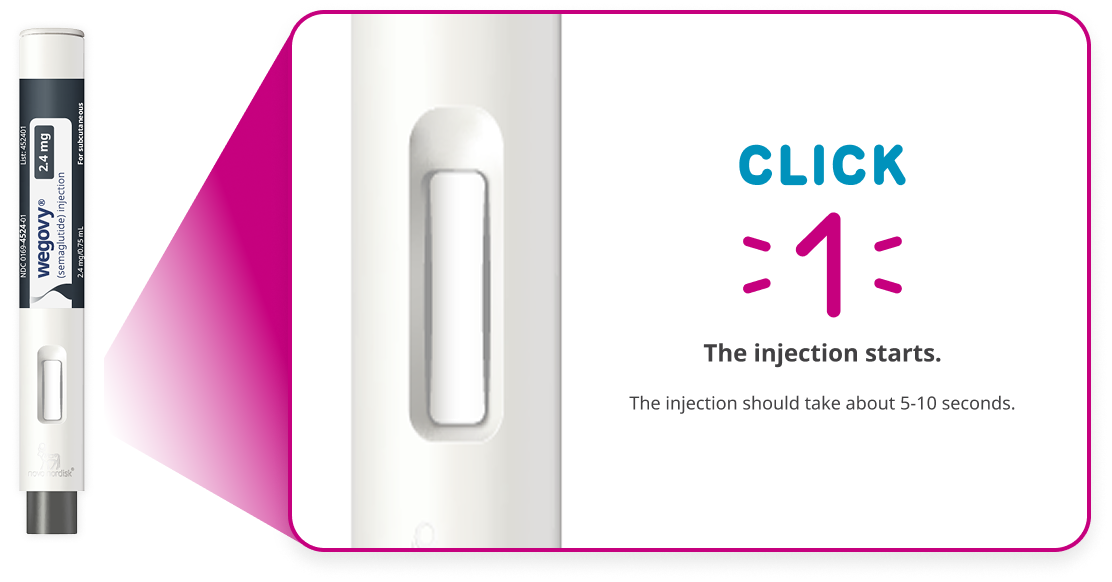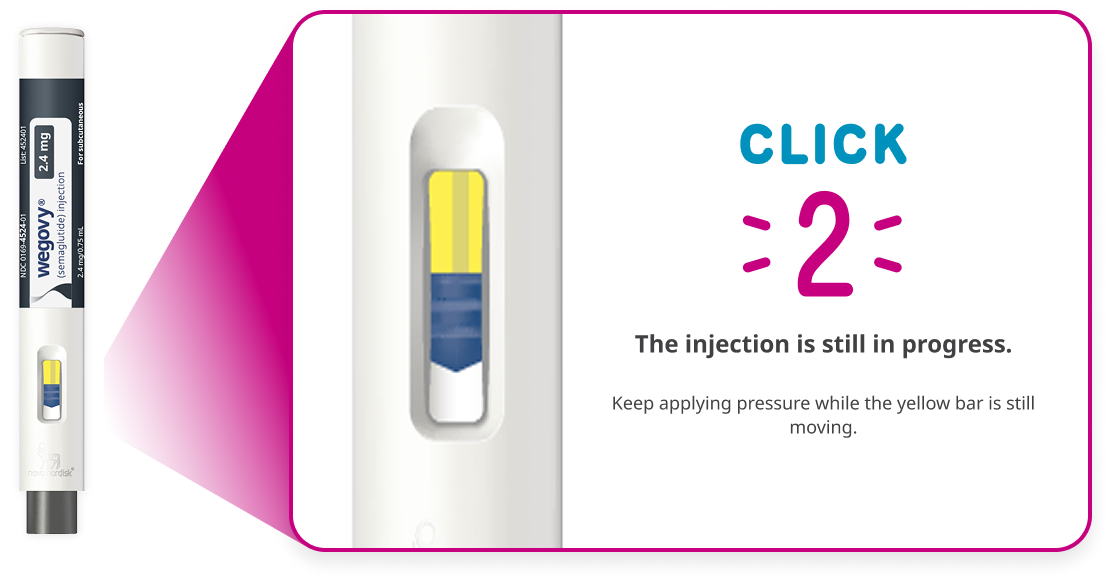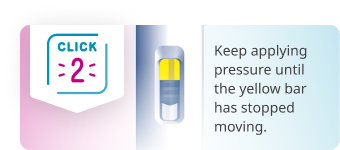Adolescents & Wegovy®
(semaglutide) injection
Learn how Wegovy®, along with a reduced calorie diet and increased physical activity, is used to help children aged 12 years and older with obesity to lose excess body weight and keep it off.

Support your adolescent's weight-management goals
If your child is 12 to 17 years old and struggles with obesity, Wegovy® may help them manage their weight.

Obesity in children
The Centers for Disease Control and Prevention (CDC) defines obesity as a disease that affects people of all ages, including adolescents.
Understanding body mass index (BMI)
BMI is a calculated measure of weight relative to height. BMI is used as a medical screening tool for assessing obesity and overweight. Obesity in children is defined as a BMI at or above the 95th percentile on sex- and age-specific growth charts.
For more information see the FAQs.
Weight management with Wegovy® in adolescents
Clinical trial results of Wegovy® in children aged 12 to 17 years
Over 1 year and 4 months (68 weeks), a medical study looked at the effect and safety of Wegovy® in adolescents with obesity. After a 3-month (12-week) screening period in which each participant received behavioral lifestyle therapy (counseling about healthy nutrition and physical activity), participants were then randomly assigned to two groups. One group was given Wegovy® while the other was given placebo (an inactive injection). Participants continued to receive lifestyle therapy throughout the trial.
Who was included in the study?
Adolescents aged 12 to 17 years old
Who had obesity with a BMI at or above the 95th percentile (according to sex- and age-specific growth charts)
The adolescents were randomly assigned into 1 of 2 groups, along with lifestyle intervention
The average starting BMI was 37.7. (The average starting weight was approximately 242 lb.)

The average starting BMI was 35.7. (The average starting weight was approximately 226 lb.)
The results showed
Adolescents taking Wegovy® had on average a
BMI reduction
Adolescents taking placebo had on average a
BMI increase
In both groups, 10% of participants discontinued the study.
In the medical study, people who stopped taking Wegovy® generally regained weight.
Let them know they've got this
Seeing what's out there can help answer some questions. But it can also lead to more. Get a better understanding of obesity and how Wegovy® may help your adolescent reach their weight-management goals.
Get to know the Wegovy® pen
Wegovy® is a prescription weight-management medication taken once weekly. It’s taken on the same day each week, at any time of the day, with or without food.
Wegovy® pen parts
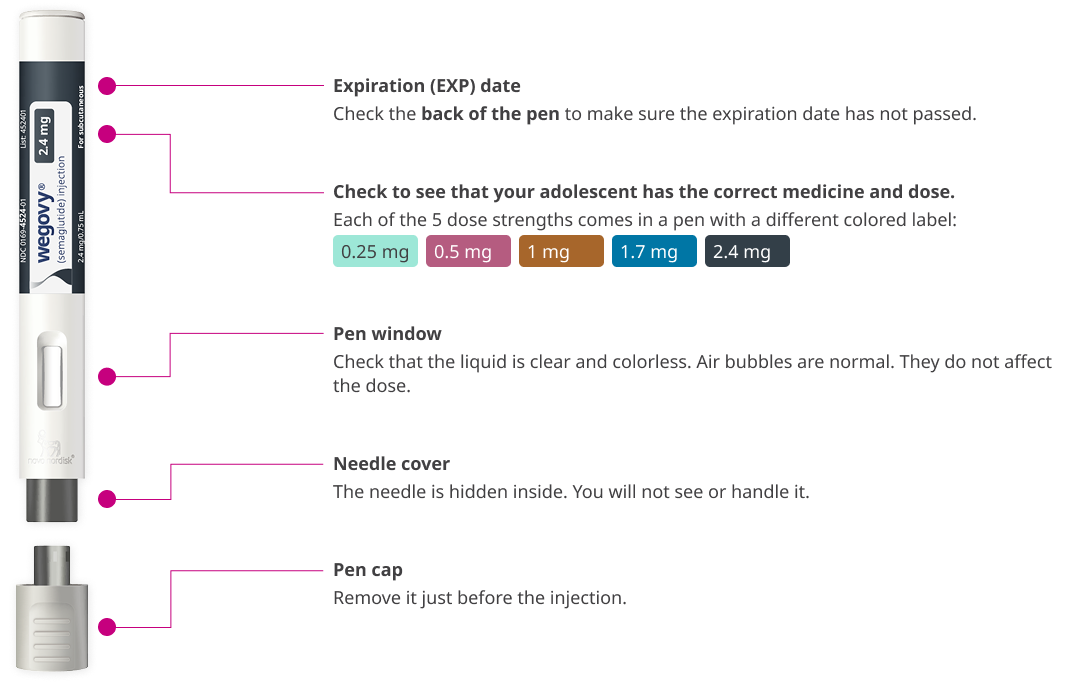
See the Wegovy® pen in action
Click or tap the arrows below to see what the Wegovy® pen will look like while you’re using it, and how to know when the injection is complete. Be sure to review the full Instructions for Use for step-by-step instructions.
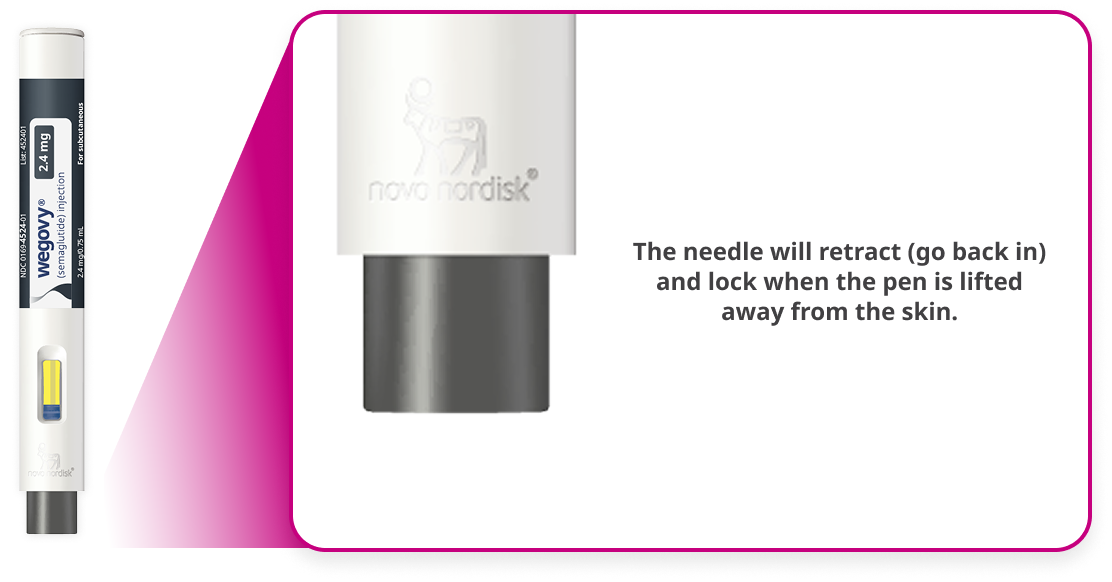
You might be wondering how to use the Wegovy® pen. Your adolescent's health care professional can show you how to take Wegovy® and answer any questions you might have about the Instructions for Use. You and your adolescent can also watch a demonstration video for using the Wegovy® pen
How to use the pen, step by step
Prepare for the injection
Choose the injection site
Remove
pen cap
Inject
Wegovy®
Throw away
the pen
Troubleshooting problems with the pen
- If your adolescent has problems injecting, they can change to a more firm injection site, such as upper leg, or upper arm. They could also consider standing up while injecting into the lower stomach
- If medicine appears on the skin or squirts from the needle, make sure the next time your adolescent injects, they keep applying pressure until the yellow bar has stopped moving. Then, they can lift the pen slowly from their skin
Protecting Wegovy® pens
- Do not drop the pen or knock it against hard surfaces
- Do not expose the pen to any liquids
- If you think that the pen may be damaged, do not try to fix it. Use a new one
- Keep the pen cap on until it is time to inject. The pen will no longer be sterile if it is stored without the cap, if the pen cap is pulled off and put on again, or if the pen cap is missing. This could lead to an infection
Storing Wegovy® pens
- Store the Wegovy® pen in the refrigerator from 36 °F to 46 °F (2 °C to 8 °C)
- If needed, before removing the pen cap, Wegovy® can be stored from 46 °F to 86 °F (8 °C to 30 °C) in the original carton for up to 28 days
- Keep Wegovy® in the original carton to protect it from light
- Do not freeze
- Throw away pen if Wegovy® has been frozen, has been exposed to light or temperatures above 86 °F (30 °C), or has been out of the refrigerator for 28 days or longer
Disposing of used pens
- It’s important to properly dispose of used Wegovy® pens. Do not throw the pen away with household trash. Instead, use an FDA-cleared sharps disposable container or a sturdy household container with a tight-fitting lid, like a heavy-duty plastic container. Make sure the container is properly labeled to warn of hazardous waste inside
- Wegovy® can be taken with or without food
- If your adolescent needs to change the day of the week that they take Wegovy®, they may do so as long as their last dose of Wegovy® was given 2 or more days before
- If too much Wegovy® is taken, it may cause severe nausea, severe vomiting, and severe low blood sugar. Contact a health care professional or go to the nearest hospital emergency room right away if your adolescent experiences any of these symptoms
Wegovy® dosing for adolescents
The starting dose of Wegovy® is 0.25 mg once weekly, and your adolescent will gradually increase their dose every 4 weeks until they reach their maintenance dose of either 1.7 mg or 2.4 mg. Work with your adolescent's health care professional to determine which dose is right for you.
Weeks 1-4 |
Weeks 5-8 |
Weeks 9-12 |
Weeks 13-16 |
Week 17+ |
|---|---|---|---|---|
Start Wegovy® at a dose of 0.25 mg per week for the first four weeks |
For weeks five through eight, the weekly dose will increase to 0.5 mg |
For weeks nine through twelve, the weekly dose will increase to 1 mg |
For weeks thirteen through sixteen, the weekly dose will increase to 1.7 mg |
From week seventeen onward, the weekly dose will either stay at 1.7 mg or increase to 2.4 mg. The maximum dose of Wegovy® is 2.4 mg |
Starting dose
Weeks 1-4 (0.25 mg)

Start Wegovy® at a dose of 0.25 mg per week for the first four weeks
Step up dosing
Weeks 5-8 (0.5 mg)

For weeks five through eight, the weekly dose will increase to 0.5 mg
Weeks 9-12 (1 mg)

For weeks nine through twelve, the weekly dose will increase to 1 mg
Maintenance dosing can be either 1.7 mg or 2.4 mg
Weeks 13-16 (1.7 mg)

For weeks thirteen through sixteen, the weekly dose will increase to 1.7 mg
Week 17+ (2.4 mg)

From week seventeen onward, the weekly dose will either stay at 1.7 mg or increase to 2.4 mg. The maximum dose of Wegovy® is 2.4 mg
Work with your adolescent's health care professional to determine the right dose.
Important tips for stepping up to the next dose
Check in with your health care professional:
- When your child is stepping up their dose
- To track their progress and see what's working for them
- If they experience any bothersome side effects or lingering side effects
If your adolescent needs to change the day they take Wegovy®, they may do so as long as their last dose was given 2 or more days before.
Missed dose?
If things don't go according to plan, your adolescent can always get back on track.
If their NEXT scheduled dose is:
Less than 2 days (48 hours) away, do not take the dose. Instead, wait to take the next dose on the regularly scheduled day.
More than 2 days (48 hours) away, take the missed dose as soon as possible.
If it's been 2 or more weeks (14 days) since their last dose, you can either ensure they take the next dose on the regularly scheduled day or talk to their health care professional about how to restart or adjust treatment.
What your adolescent might expect
The most common side effects of Wegovy® may include:
- Nausea
- Diarrhea
- Vomiting
- Constipation
- Stomach (abdomen) pain
- Headache
- Tiredness (fatigue)
- Upset stomach
- Dizziness
- Feeling bloated
- Belching
- Low blood sugar in people with type 2 diabetes
- Gas
- Stomach flu
- Heartburn
- Runny nose or sore throat
Pay attention to how your adolescent is feeling and talk with their health care professional about any side effects they experience.
For adolescents aged 12 to 17 years, the side effects of Wegovy® were generally similar to those seen in adults. However, in the adolescent study, adolescents had a higher chance of experiencing gallstones, gallbladder inflammation, low blood pressure, rash, and hives compared with studies of adults treated with Wegovy®.
Wegovy® and type 2 diabetes
There is not enough information to know if Wegovy® raises the risk of low blood sugar in adolescents with type 2 diabetes, like what is seen in adults. If your adolescent has type 2 diabetes and is prescribed Wegovy® for obesity, talk with their health care professional to understand the risk of low blood sugar as well as how to recognize the signs and symptoms. Their health care professional will check their blood sugar prior to starting Wegovy® and throughout treatment. As they’re getting started with Wegovy®, their health care professional might lower the doses of other diabetes medicines they may be taking (like sulfonylureas or insulin) to lessen the chance of low blood sugar.
Talk it out with your care team
Let your adolescent’s care team know about any side effect that bothers them or doesn’t go away. Everyone is different, so your adolescent's health care professional can help you determine the best course of action. If your adolescent experiences nausea, talk with their health care professional for guidance, which may include some of these general tips.
Tips for managing nausea
Eat bland, low-fat foods, like crackers, toast, and rice
Go outdoors for fresh air
Eat foods that contain water, like soups and gelatin
Eat more slowly
Avoid lying down after you eat
Avoid greasy foods
Discuss all possible side effects of Wegovy® with your health care professional.
Your adolescent’s health care professional is always the best person to go to for answers about side effects of Wegovy®, stepping up your adolescent’s dose, and beyond.
You can also find details in the Wegovy® Medication Guide or call the Wegovy® Navigation Line at 1-833-4-WEGOVY (1-833-493-4689) Monday-Friday between 9:00 am and 6:00 pm ET.
Frequently asked questions
Wegovy® works by mimicking a hormone called GLP-1 (glucagon-like peptide-1), which targets areas of the brain involved in regulating appetite and food intake. This can help your adolescent eat less, which can lead to weight loss.
When combined with a reduced calorie diet and increased physical activity, a 68-week medical study* of 201 adolescents aged 12 to 17 years with obesity showed that adolescents taking Wegovy® lowered their body mass index (BMI) by 16.1% while those taking placebo (an inactive injection) raised their BMI by 0.6%.
You should discuss with your health care professional the BMI of your adolescent to determine if they are suited for Wegovy®.
*Results are from a 68-week medical study of 201 adolescent patients aged 12 to 17 years with a BMI in the 95th percentile or higher (according to sex- and age-specific growth charts) that compared Wegovy® with placebo. Both groups received counseling on healthy nutrition and physical activity for weight loss. The average starting BMI for people taking Wegovy® was 37.7 kg/m2. The average starting BMI for people taking placebo was 35.7 kg/m2.
Because of adolescents' weight and height change during growth and development, BMI is represented as a percentile using age- and sex-specific growth charts. The percentile tells us the adolescent’s BMI in relation to peers of the same age and sex. For example, if a 15-year-old boy has a BMI in the 50th percentile, his BMI is higher than the BMIs of 50% of 15-year-old boys. Obesity is defined as a BMI at or above the 95th percentile at the time the growth charts were developed.
Chronic diseases like obesity usually require long-term management. Your adolescent’s health care professional can create a plan tailored to their weight-management goals. Your adolescent should visit their health care professional to review their progress and renew their prescription.
At the end of the adolescent medical study, patients stopped Wegovy® and were observed for 7 weeks on lifestyle therapy only. After stopping Wegovy®, weight regain was observed.
The health care professional should teach you and your adolescent how to inject Wegovy® before they take it for the first time. If either of you have questions or do not understand the instructions, ask a health care professional. See the full Instructions for Use that come with the Medication Guide for detailed information about the right way to use the Wegovy® pen.
Wegovy® is injected under the skin (this is called a subcutaneous injection) in the upper leg (front of the thigh), lower stomach (keep 2 inches away from belly button), or upper arm as instructed by a health care professional. Wegovy® is not to be injected into a vein or muscle. See the full Instructions for Use that come with the Medication Guide for detailed information about the right way to use the Wegovy® pen.
Adverse reactions with Wegovy® treatment in adolescent patients aged 12 to 17 years were similar to those reported in adults. However, adolescent patients aged 12 years and older treated with Wegovy® in a study had a higher incidence of gallstones, gallbladder inflammation, low blood pressure, rash, and hives compared with studies of adults treated with Wegovy®.
The most common side effects of Wegovy® may include: nausea, diarrhea, vomiting, constipation, stomach (abdomen) pain, headache, tiredness (fatigue), upset stomach, dizziness, feeling bloated, belching, low blood sugar in people with type 2 diabetes, gas, stomach flu, heartburn, and runny nose or sore throat.
If your adolescent experiences any side effects, tell their health care professional.
The free WeGoTogether® personalized support program is designed for patients 18 years or older; however, as a caregiver you may access the Wegovy® Navigation Line at 1-833-4-WEGOVY if you would like more information.
If your adolescent is ready to start Wegovy®, check your options for cost and coverage with our easy-to-use tool.



